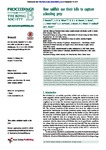How sailfish use their bills to capture schooling prey
| dc.contributor.author | Domenici, P | |
| dc.contributor.author | Wilson, Alexander | |
| dc.contributor.author | Kurvers, RHJM | |
| dc.contributor.author | Marras, S | |
| dc.contributor.author | Herbert-Read, JE | |
| dc.contributor.author | Steffensen, JF | |
| dc.contributor.author | Krause, S | |
| dc.contributor.author | Viblanc, PE | |
| dc.contributor.author | Couillaud, P | |
| dc.contributor.author | Krause, J | |
| dc.date.accessioned | 2018-05-09T10:23:01Z | |
| dc.date.available | 2018-05-09T10:23:01Z | |
| dc.date.issued | 2014-06-07 | |
| dc.identifier.issn | 0962-8452 | |
| dc.identifier.issn | 1471-2954 | |
| dc.identifier.other | 20140444 | |
| dc.identifier.uri | http://hdl.handle.net/10026.1/11453 | |
| dc.description.abstract |
<jats:p> The istiophorid family of billfishes is characterized by an extended rostrum or ‘bill’. While various functions (e.g. foraging and hydrodynamic benefits) have been proposed for this structure, until now no study has directly investigated the mechanisms by which billfishes use their rostrum to feed on prey. Here, we present the first unequivocal evidence of how the bill is used by Atlantic sailfish ( <jats:italic>Istiophorus albicans</jats:italic> ) to attack schooling sardines in the open ocean. Using high-speed video-analysis, we show that (i) sailfish manage to insert their bill into sardine schools without eliciting an evasive response and (ii) subsequently use their bill to either tap on individual prey targets or to slash through the school with powerful lateral motions characterized by one of the highest accelerations ever recorded in an aquatic vertebrate. Our results demonstrate that the combination of stealth and rapid motion make the sailfish bill an extremely effective feeding adaptation for capturing schooling prey. </jats:p> | |
| dc.format.extent | 0-0 | |
| dc.format.medium | Electronic-Print | |
| dc.language | en | |
| dc.language.iso | en | |
| dc.publisher | The Royal Society | |
| dc.subject | predator-prey interactions | |
| dc.subject | fish schools | |
| dc.subject | animal weapons | |
| dc.subject | billfishes | |
| dc.title | How sailfish use their bills to capture schooling prey | |
| dc.type | journal-article | |
| dc.type | Journal Article | |
| dc.type | Research Support, Non-U.S. Gov't | |
| plymouth.author-url | https://www.webofscience.com/api/gateway?GWVersion=2&SrcApp=PARTNER_APP&SrcAuth=LinksAMR&KeyUT=WOS:000335382700027&DestLinkType=FullRecord&DestApp=ALL_WOS&UsrCustomerID=11bb513d99f797142bcfeffcc58ea008 | |
| plymouth.issue | 1784 | |
| plymouth.volume | 281 | |
| plymouth.publication-status | Published | |
| plymouth.journal | Proceedings of the Royal Society B: Biological Sciences | |
| dc.identifier.doi | 10.1098/rspb.2014.0444 | |
| plymouth.organisational-group | /Plymouth | |
| plymouth.organisational-group | /Plymouth/Faculty of Science and Engineering | |
| plymouth.organisational-group | /Plymouth/Faculty of Science and Engineering/School of Biological and Marine Sciences | |
| plymouth.organisational-group | /Plymouth/REF 2021 Researchers by UoA | |
| plymouth.organisational-group | /Plymouth/REF 2021 Researchers by UoA/UoA07 Earth Systems and Environmental Sciences | |
| plymouth.organisational-group | /Plymouth/Users by role | |
| plymouth.organisational-group | /Plymouth/Users by role/Academics | |
| dc.publisher.place | England | |
| dcterms.dateAccepted | 2014-03-25 | |
| dc.identifier.eissn | 1471-2954 | |
| dc.rights.embargoperiod | Not known | |
| rioxxterms.versionofrecord | 10.1098/rspb.2014.0444 | |
| rioxxterms.licenseref.uri | http://www.rioxx.net/licenses/all-rights-reserved | |
| rioxxterms.licenseref.startdate | 2014-06-07 | |
| rioxxterms.type | Journal Article/Review |


